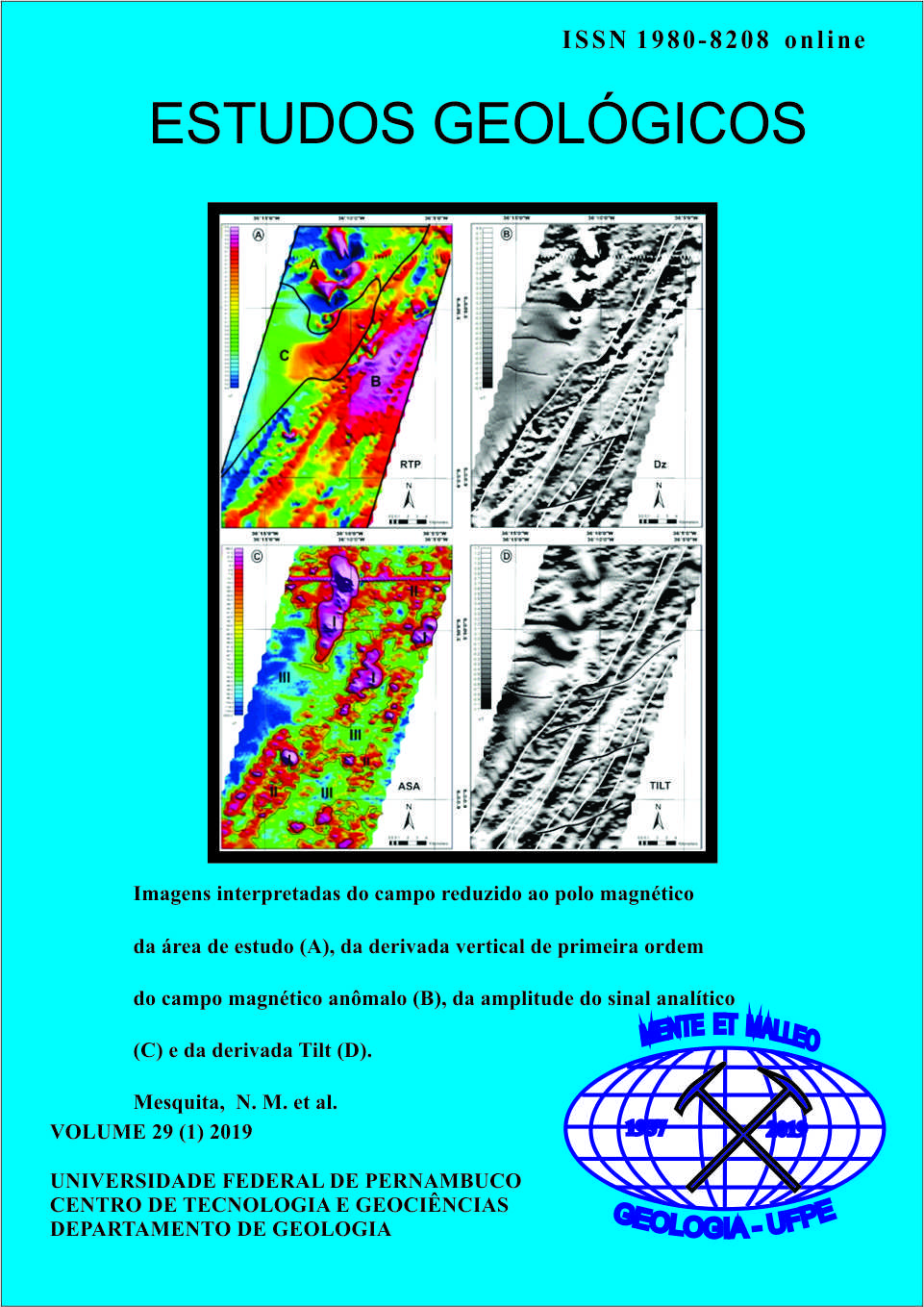A histologia como uma ferramenta no estudo dos fósseis: considerações sobre a paleohistologia em mamíferos com carapaça óssea
DOI:
https://doi.org/10.51359/1980-8208/estudosgeologicos.v29n1p196-210Palavras-chave:
Microestrutura óssea, osteodermos, Cingulata, Xenarthra, tecido ósseoResumo
Mesmo após milhões de anos de soterramento, muitos vertebrados ainda apresentam a estrutura histológica do tecido ósseo preservada. Aspectos ontogenéticos, reconheci-mento de feições fossildiagenéticas, aprimoramento de estudos sistemáticos e anatômi-cos são os principais pontos abordados pelos estudos paleohistológicos. Dentre os ver-tebrados, os grupos mais estudados por esta ótica foram os dinossauros, pterossauros, ictiossauros, crocodilomorfos, testudines, cinodontes e peixes, sendo ainda discretos os estudos realizados com mamíferos, especialmente os mamíferos com carapaça óssea. Este trabalho pretende reunir o conhecimento disponível acerca da histologia de osteo-dermos de mamíferos cingulados, de forma a apresentar um panorama dos trabalhos atuais e um ponto de partida para futuros trabalhos.Referências
Ahmed,W.,Voort, G. V.,2003. Speci-men preparation of bones, tissues and other similar materials. Bueh-ler LtdTech-Notes 3(8).
Ameghino,F.,1889. Contribución al conocimiento de los mamíferos fósiles de laRepública Argentina. Actas de laAcademiaNacional deCiencias deCórdoba,6: 1-1027.
Amson,E.,Muizon,C., Laurin,M., Argot,C.,Buffrénil,V.,2014. Gradual adaptation of bone struc-ture to aquatic lifestyle in extinct sloths from Peru. Proceedings of the Royal Society B.281:1–6.DOI 10.1098/rspb.2014.0192.
Andrade, R.L.P.,Sayão,J.M., 2014.Paleohistology and lifestyle infer-ences of a dyrosaurid (Archo-sauria: Crocodylomorpha) from Paraíba Basin (Northeastern Bra-zil). PLoS ONE,9(7): e102189.
Araújo, S. E., Porpino, K. O., 2018 His-tological variation in osteoderms Panochthus sp. and Glyptotheri-um sp. (Xenarthra: Mammalia) from the BrazilianIntertropical Region. Revista Brasileira dePa-leontologia, 21(2):141–157.
Asakura, Y., Da Costa Pereira, P.V.L.G., Oliveira, E.V., and Lopes Da Silva, J.L.,2017. Comparative paleohistology in osteoderms ofPleistocene Panochthussp. Bur-meister, 1886and Neuryurussp. Ameghino, 1889 (Xenarthra, Glyptodontidae). Comptes Rendus Palevol,16 (7): 795–803
Aureliano,T.,Ghilardi,A.M.,Buck,P.V.,Fabbri,M.,Samathi,A.,Delcourt,R.,Fernandes,M.A.,Sander,M., 2018. Semi-aquatic adaptations in a spinosaur from the Lower Cretaceous of Brazil. Cretaceous Research,90: 283-295.
Botha, J.,Chinsamy, A., 2000. Growth patterns deduced from the bone histology of the cynodonts Di-ademodon and Cynognathus. Journal of Vertebrate Paleontolo-gy 20(4):705–711
Buffrénil, V., Clarac,F.,Fau,M.,Mar-tin,S.,Martin,B., Pellé,E., Lau-rin, M., 2015.Differentiation and growth of bone ornamentation in vertebrates: a comparative histo-logical study among the Croco-dylomorpha. Journal of Morphol-ogy, 276: pp. 1-21, 10.1002/jmor.20351
Carlini, A.A.,Zurita, A., 2010.An In-troduction to Cingulate Evolution and their Evolutionary History during the Great American Biotic Interchange: Biogeographical clues from Venezuela. In: Sán-chez-Villagra, M. R., Aguilera, O. A., Carlini,A.A. (Eds.) Urumaco and VenezuelanPaleontology. In-diana UniversityPress, p. 233-255.
Chávez-Aponte, E.O.,Alfonzo-Hernández, I.,Finol, H. J.,Barri-os, C.E.,Boada-Sucre, A., Carril-lo-Briceño,J.D., 2008.Histología y ultraestructura de los osteoder-mosfósiles de Glyptodon clavipesy Holmesinasp. (Xenarthra: Cin-gulata). Interciencia,33:616–619.
Cheng, X.,Bantim, R.A.M.,Sayão,J.M.,Kellner,A.W.A.,Wang, X.,Saraiva, A.A.F., 2018. The larg-est flying reptile from the CratoFormation, Lower Cretaceous, Brazil. Historical Biology, DOI: 10.1080/08912963.2018.1491567.
Chinsamy, A., 1997.Assessing the bi-ology of fossil vertebrates through bone histology. Palaeontologia Africana33: 29–35.
Chinsamy, A.,Chiappe, L.M.,Dodson,P., 1995Mesozoic avian bone mi-crostructure: physiological impli-Yumi Asakura& Edison Vicente Oliveira.
Chinsamy, A.,Chiappe, L.M.,Marugán-Lobón,J.,Chunling, G.,Fengjiao, Z., 2013.Gender identi-fication of the mesozoic bird Con-fuciusornis sanctus. Nature Communication, 4:138
Chinsamy, A.,Codorniú, L.,Chiappe, L., 2009.Palaeobiological Impli-cations of the Bone Histology of Pterodaustro guinazui. The Ana-tomical Record292:1462–1477.
Chinsamy, A.,Raath,M.A., 1992.Preparation of bone for histologi-cal study. Palaeontologia Africana29:39-44.
Ciancio,M. R,Krmpotic,C. M,Scara-noA. C,Epele,M. B., 2017. In-ternal morphology of osteoderms of extinct armadillos and its rela-tionship with environmental con-ditions. Journal of Mammalian Evolution, DOI:10.1007/s10914-017-9404-y
Cunningham,J.A.,Rahman,I.A.,Lautenschlager,S.,Rayfield,E.J.,Donoghue,P.C.J.,2014. A virtu-al world of paleontology. Trends in Ecology & Evolution,29: 6
Da Costa Pereira, P. V. L. G., Victer, G. D., Porpino, K. O., Bergqvist, L.P., 2014.Osteoderm histology of Late Pleistocene cingulates from the intertropical region of Brazil. Acta Palaeontologica Polonica59(3): 543–552
Davidson,M.,2010. Robert Hooke—Physics, architecture, astronomy, paleontology, Biology. Lab Medi-cine,41(3): 180–182.
De Boer, H.H., Van Der Merwe,A.E., Maat, G.J.R., 2013.The diagnos-tic value of microscopy in dry bone palaeopathology: A review. International Journal of Paleo-pathology,3:113-121
Doube,M.,Kłosowski,M.M.,Argan-da-Carreras I.,Cordelières.F.P.;Dougherty,R.P.,Jackson,J.S. Schmid,B.,Hutchinson,J.R.,Shefelbine,S.J., 2010. BoneJ: Free and extensible bone image analysis in ImageJ. Bone, 47:1076–1079
Duque, R.R.C., Barreto, A.M.F., 2018. New exceptionally well-preserved Pterosauriafrom the Lower Cretaceous Araripe Basin, Northeast Brazil. Cretaceous Re-search 91:299-311
Enlow,D.H., 1963.Principles of bone remodeling. Thomas, Springfield, Illinois
Evans,D.C.,Hayashi,S.,Chiba,K.,Watabe,M.,Ryane,M.J.,Leeg,Y-N.,Currieh,P.J.,Tsogtbaatari,K.,Barsboldi.R., 2018. Morphol-ogy and histology of new cranial specimens of Pachycephalosauri-dae (Dinosauria: Ornithischia) from the Nemegt Formation, Mongolia. Palaeogeography, Pal-aeoclimatology, Palaeoecology,494:121–134
Fernicola, J. C., Porpino, K.O., 2012.Exoskeleton and Systematics: A Historical Problem in the Classifi-cation of Glyptodonts. Journal of Mammalian Evolution 19(1): 1-13.
Francillon-Vieillot, H., DeBuffrénil, V., Castanet, J., Géraudie, J., Meunier, F.J.,Sire, J.Y., Zylber-berg, L., Ricqlès, A., 1990.Mi-crostructure and mineralization of vertebrate skeletal tissues. In: Carter, J.G. (Ed). Skeletal Bio-mineralization: Patterns, Process-es and Evolutionary Trends. New York: Van Nostrand Reinhold, p 471–530.
Girondot, M.,Laurin, M., 2003.Bone Profiler: a tool to quantify, model, and statistically compare bone-section compactness profiles. Journal of Vertebrate Paleontolo-gy,23: 458–461
Downloads
Publicado
Edição
Seção
Licença
Copyright (c) 2019 Estudos Geológicos

Este trabalho está licenciado sob uma licença Creative Commons Attribution 4.0 International License.
Os direitos autorais para os textos publicados são do autor, com direitos do periódico sobre a primeira publicação. Os autores somente poderão utilizar os mesmos textos em outras publicações indicando claramente este periódico como o meio da publicação original.



